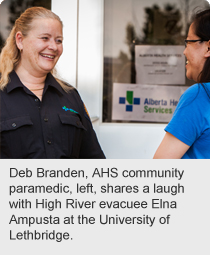
July 19, 2013
Story by Sherri Gallant; photo by Rob Olson
The Swiss army knives of community-based care.
That’s how Thomas Mountain, Manager of Addiction and Mental Health for the South Zone of Alberta Health Services, describes the work and versatility of community paramedics during recent flood relief efforts in southern Alberta.
“Soon after our satellite health care team at the University of Lethbridge (U of L) became operational, everyone came to recognize that they were essential members of the multidisciplinary health care team,” Mountain says.
 Community paramedics are a relatively new role within AHS. These specially trained paramedics are able to perform some assessments, diagnostics and treatments in the community that would otherwise need to be done in an AHS facility.
Community paramedics are a relatively new role within AHS. These specially trained paramedics are able to perform some assessments, diagnostics and treatments in the community that would otherwise need to be done in an AHS facility.
These services include using an electrocardiogram to measure electrical activity in the heart; monitoring vital signs; collecting laboratory specimens; administering medications; treating wounds; catheterization; and rehydration therapy.
Two community paramedics, Lethbridge-based Deb Branden and Vauxhall-based Angeline Abela, were involved in flood relief efforts in Medicine Hat, as well as at the
U of L reception centre for High River evacuees.
“I went with EMS to Medicine Hat for three days and we helped set up the urgent care centre on the east side of the city,” says Branden. “That was quite interesting, just assisting people with their basic needs of displacement – needs of medication, minor wound care, prescriptions, housing.”
In Lethbridge, Branden and Abela arranged eye exams, obstetrics exams and referrals to physicians and mental health providers,
“It was very rewarding to help people and get them on the right track toward getting their lives back together,” says Branden.
Abela says she enjoyed being part of a stabilizing presence for displaced High River residents.
“When I was up at the U of L helping to set up the reception centre, people were just starting to come in,” she says. “A lot of the immediate need for that population had already been taken care of at the reception centres in Calgary, so our role was mainly to be there for them. To be accessible, to sit and talk with them, listen to them. Provide an environment for them where they could kind of settle a little bit.”
Mountain says both women’s efforts were appreciated.
“With their broad scope of practice, they were able participate in patient care wherever needed, enhancing the services our team provided,” he says.
“Whether they were called upon to take vitals, co-ordinate prescription refills, make referrals to primary care physicians, provide wound care, treat heat exhaustion, be prepared to respond to emergencies, or provide a listening ear, no job was too big or small for our community paramedics.
“Overall, the ability of the community paramedic team to bridge several services meant the rest of our AHS team could go about our tasks with confidence, knowing that we had the additional support we needed to bridge our areas of expertise.”